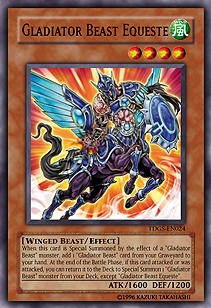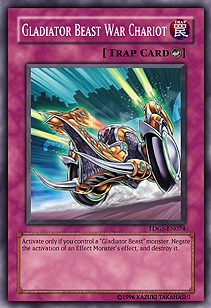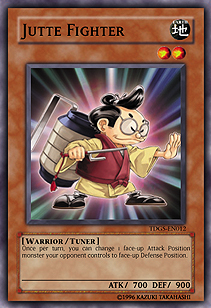In the weeks following Shonen Jump Championship Baltimore, I paraded around my locals, bragging about how my favorite deck triumphed over Dark Armed Dragon’s newest form, and I guaranteed everyone that Gladiator Beasts would put forth an equally impressive showing at Shonen Jump Tulsa.
 But I was wrong.
But I was wrong.
When the Top 16 decklists were posted, I was shocked by the lone Gladiator Beast deck, run by Chris Bryson, that had made it to Day 2. When that deck failed to reach the Top 8, many people jumped to the conclusion that the future was bleak for Gladiator Beast decks in competitive metagames. People keeping an eye on Shonen Jump Tulsa most likely saw Gladiator Beast decks consistently losing to Teleport Dark Armed decks, and concluded that the matchup was unfavorable for the Gladiator Beast player.
But it doesn’t need to be.
Gladiator Beasts today are not the same as they were last format. Not only did they receive two new support cards (Gladiator Beast War Chariot and Gladiator Beast Equeste) in The Duelist Genesis, but their old tricks won’t work against Stardust Dragon, the number one Synchro monster pick against Gladiators. Stardust will negate Gladiator Beast Gyzarus’s powerhouse effect, as well as other common forms of monster removal like Gladiator Beast Murmillo, Smashing Ground, and Bottomless Trap Hole. In the Gladiator decks last format, Book of Moon was one of the few answers to Stardust, and even Book required a strong follow-up play while Stardust was face down and unable to protect itself.
The solution to Stardust Dragon is a reworked build of Gladiator Beasts that can counter the emerging dominance of Teleport Dark Armed. Jason already described the importance of tech like Compulsory Evacuation Device in The Binder: Baltimore Tech, and he stressed the importance of disruption from D.D. Crow, but there are even more solutions for Gladiator Beast players willing to adapt to a shifting metagame.
Phoenix Wing Wind Blast is not always as good as Compulsory Evacuation Device when used specifically against a Synchro monster, since it has the drawback of a discard cost, but it is likely to become an increasingly popular main-deck choice for Gladiator Beasts because of its versatility. Discarding a card—perhaps even one you want in the graveyard (like discarding Gladiator Beast Bestiari to bring it back with Gladiator Beast Darius)—is a small cost to pay to clear the field of Stardust Dragon and open up other moves. At other times, Wind Blast is capable of returning a dead draw to the top of the opponent’s deck, like Destiny Hero - Malicious or Wulf, Lightsworn Beast (during the Wind Blast player’s own turn, of course, so the opponent doesn’t get the opportunity to send Wulf from the deck to the graveyard with an end phase effect). The ability to manipulate the opponent’s draws also allows a player to keep track of the opponent’s hand and play accordingly. To add to its versatility, Phoenix Wing Wind Blast also lets a player spin away an opponent’s trap card in order to set up for a safe summon of Gyzarus or a safe attack from Gladiator Beast Secutor.
Many duelists have come to appreciate the synergy between Phoenix Wing Wind Blast and Gladiator Beast Equeste, and opted to play these cards together. It’s a logical decision, since Equeste can bring back Gladiator Beast cards discarded by Wind Blast, effectively nullifying Wind Blast’s cost. But there’s an even more enticing reason to play Equeste, and it’s one of the most powerful themed trap cards in the game right now: Gladiator Beast War Chariot, which Equeste can retrieve for you.
You cannot throw Gladiator Beast War Chariot into any Gladiator deck and expect it to work well. It depends on Gladiator Beast monsters for that. If there are no Gladiator monsters on the field, War Chariot becomes a dead card. But the strengths of the Chariot cannot be ignored. It is capable of negating some of the most powerful monster effects in the game, while destroying the monster connected to them. Destiny Hero - Malicious, D.D. Crow, and Honest all get blindsided by Chariot, when even Solemn Judgment wouldn’t be able to stop them. Each Lightsworn monster can be destroyed by it when that monster sends cards from the deck to the graveyard, or when it activates another effect. Dark Armed Dragon and Judgment Dragon, two of the most feared cards in the current metagame, are also negated and destroyed when Chariot is activated.
While Gladiator Beast War Chariot admittedly has a strong effect, how much are players willing to sacrifice to be able to use it effectively? Most Gladiator Beast decks use Elemental Hero Prisma and  together to quickly summon Gyzarus, wiping out two cards and taking control of the field. Many of these decks also run Elemental Hero Stratos to help establish field presence and support the Prisma that speeds the deck along.
together to quickly summon Gyzarus, wiping out two cards and taking control of the field. Many of these decks also run Elemental Hero Stratos to help establish field presence and support the Prisma that speeds the deck along.
The problem? None of these cards are Gladiator Beast monsters, so none of them allow the activation of Chariot. Other monsters frequently played in Gladiator Beast decks (like Sangan and D.D. Crow) as well as less common picks like Morphing Jar, Spirit Reaper, Breaker the Magical Warrior, D.D. Warrior Lady, and Neo-Spacian Grand Mole, are also disappointing to draw when you’re holding Chariot and don’t have a Gladiator Beast monster. The obvious fix would be to give up the Elemental Hero engine along with some other non-Gladiator tech choices, and focus the deck around the Gladiator Beast monsters with more duplicate and triplicate copies of each. Even the effective use of Waboku could play a role. While this would decrease the speed of the deck and the ability to quickly shift field presence, it would also create consistency based around a dedicated central theme.
Luckily, an early Gyzarus summon is still possible by discarding Gladiator Beast Bestiari with Phoenix Wing Wind Blast. These changes would greatly reduce the chance of War Chariot becoming a dead draw and the frequency of drawing Waboku without a Gladiator Beast monster. It could also make it easier to summon Gladiator Beast Heraklinos through Secutor, which is often difficult for Teleport Dark Armed decks to deal with. Unfortunately, while these particular changes can help when you are playing against Teleport Dark Armed decks, they make the "Gladiator-Hero" matchup less favorable. As a result, the best deck to enter into a tournament can only be determined with a good metagame read.
Players unwilling to give up the speed that Prisma provides, and willing instead to sacrifice the effectiveness of War Chariot, have other ways to combat current trends in the average metagame. D.D. Warrior Lady has been gaining popularity lately. Not only can she be searched out by Reinforcement of the Army—a card that many Gladiator Beast decks already play—she can also get opposing copies of Stardust Dragon and Gladiator Beast Heraklinos off the table. Those two control cards tend to stick around after hitting the field, and Warrior Lady is a simple solution to both. 1500 ATK isn’t too bad either when you’re on the offensive, especially since you know that whatever attacks the Lady will be removed from play.
Like D.D. Warrior Lady, Neo-Spacian Grand Mole can also get rid of Synchro and Fusion monsters by attacking them. But unlike Warrior Lady, Grand Mole returns to its owner’s hand to repeat the process when he’s needed again. The Mole has always been one of my favorite cards. The frustration opponents experience when they’re down on field presence and keep having the monster they play returned to their hand reminds me of players getting repeatedly attacked by Yata-Garasu shortly after I started playing the Yu-Gi-Oh! TCG. Surprisingly, Neo-Spacian Grand Mole also has great synergy with some of the individual Gladiator Beasts. He can lock down the field while Heraklinos locks down the hand, or he can clear the field to let a Gladiator Beast attack and tag into something more useful. Grand Mole was an effective main-deck choice last format, but with the current dependence on Fusions and Synchros to win games, he’s even better.
Two other cards that have deservedly seen more use are Brain Control and Dimensional Prison. When I played in Shonen Jump Baltimore, I ran Brain Control because of its strength in the Gladiator Beast mirror match. The ability to gain control of an opponent’s Gladiator and tag it out (or Fuse it for Gyzarus) provides a huge swing and instant advantage. But Brain Control turned out to be one of the most effective spells in my deck in the Teleport Dark Armed matchup as well. Just being able to gain control of Stardust Dragon to open up Gyzarus plays for a turn is good. Being able to attack a second Stardust afterward is even better. But gaining control of Stardust so that a Gladiator Beast monster can attack and tag out for Murmillo to kill the very Dragon you assumed control of is just awesome. Players need to remember that while Stardust Dragon isn’t under the opponent’s control, it’s vulnerable to whatever may destroy it. Brain Control allows a player to take advantage of that, and many players have decided to run Enemy Controller to abuse this fact even further.
While I don’t particularly like Dimensional Prison because it can’t be chained to trap destruction, it provides a simple solution to Stardust Dragon, which is cause enough for many duelists to play it. It also provides an answer to any other attacker. Some players like Bryson and Jermol Jupiter have even decided to play it over Mirror Force, an interesting choice specifically made for the Teleport Dark Armed match.
While it hasn’t seen much play recently in Gladiator Beast decks, Shrink also deserves a mention. Its usefulness in battle provides perfect synergy with the Gladiator Beast "tag-out" requirement, and halving the ATK of Stardust Dragon to 1250 makes it easy to destroy in battle.
A formerly popular deck choice that I anticipate seeing a decreased amount of play in Gladiator Beast decks is Bottomless Trap Hole. Teleport Dark Armed players will most often bring out Stardust Dragon over all other level-8 Synchro monsters when dueling a Gladiator Beast deck, because the other level-8 Synchros can still be destroyed by the Gladiators’ most common forms of destruction: Gladiator Beast Gyzarus and Gladiator Beast Murmillo. But Bottomless Trap Hole is nearly useless against Stardust, since it can simply tribute itself and return to the field at the end phase. Bottomless is still effective against Goyo Guardian and other big attackers like Breaker, Stratos, and Dark Grepher, but these monsters don’t pose nearly as much of a problem for the Gladiator Beast player as Stardust Dragon. Smashing Ground, while amazing in the Gladiator Beast mirror match, has the same problem as Bottomless when you’re playing against Teleport Dark Armed, and you might benefit from shifting it back and forth between your main and side decks.
One of the strongest cards for Gladiator Beast players to take against Teleport Dark Armed is actually one of the best Synchro monsters in Teleport Dark Armed: Goyo Guardian. Using Monster Reborn or Brain Control on Krebons can bring out Goyo Guardian, letting you steal some of the opponent’s  strongest cards. I did that several times to destroy Stardust Dragon in Shonen Jump Baltimore, and if I didn’t have Goyo in my Extra deck, many of the games I won would not have been as favorable for me.
strongest cards. I did that several times to destroy Stardust Dragon in Shonen Jump Baltimore, and if I didn’t have Goyo in my Extra deck, many of the games I won would not have been as favorable for me.
But why should Gladiator Beasts be restricted to using the opponent’s cards to summon Goyo Guardian? If the Gladiator Beast player is using multiple copies of Reinforcement of the Army, it’s easy to splash one or two copies of Jutte Fighter, which already has synergy with Brain Control and Enemy Controller. Even Mind Control is a viable option for the deck. It works great with Jutte, and is even better against Gladiator Beast decks since it makes contact Fusing for Gyzarus easier. This is obviously all very difficult to incorporate into a dedicated Gladiator deck running three copies of Gladiator Beast War Chariot, but it’s certainly feasible for the less dedicated Gladiator build.
Waboku, another card that’s effective in Gladiator Beast decks, has seen a decreased amount of play since Gladiator Beasts first emerged as a dominant deck type. Many duelists don’t like the fact that it requires another Gladiator Beast to be effective. But with Jutte Fighter, Waboku gets even better. Not only can it allow a "tag-out" when the opponent attacks a Gladiator Beast, but it can also ensure the survival of a monster to Synchro summon with.
There are several ways to build a Gladiator Beast deck now, some more dedicated to the theme than others. All of them should have a side deck prepared to answer major obstacles in the expected metagame, particularly Teleport Dark Armed. Shadow-Imprisoning Mirror is a solid pick. Losing Gyzarus’s destruction effect is a small sacrifice to shut down nearly all of the monsters in the Teleport deck. Royal Oppression, while shutting down many more cards in Gladiators than Shadow Mirror, also completely nullifies the entire strategy behind Teleport Dark Armed. In the deck Adam Corn played to win Shonen Jump Tulsa, Emergency Teleport, Dark Armed Dragon, Destiny Hero - Malicious, and Monster Reborn are all negated by Royal Oppression. That’s nearly one-fourth of the deck! Plus cards like Dark Grepher and Caius the Shadow Monarch become weaker. Grepher’s special summon can be negated, and Caius is difficult for the deck to tribute summon without a special summon preceding him. But my favorite side deck card against Teleport Dark Armed has already been explored quite a bit. Compulsory Evacuation Device can’t backfire like Royal Oppression if your opponent manages to regain field presence. It’s a better topdeck when you’re behind, and returning a Synchro monster back to the Extra deck at any time is as good as removing it from play.
The ability to use your side deck effectively is one of the reasons Gladiator Beasts remain my favorite deck in the current format. Cards can be switched out between the main deck and side deck with relative ease, and you can do it without annihilating the core theme. Cards that affect both players, like Light-Imprisoning Mirror and Shadow-Imprisoning Mirror, can be used for the Gladiator player’s benefit. This often gives the Gladiator Beast player an advantage in the second and third games of a match. Using a side deck for a theme with a concentrated strategy like Lightsworn is much more difficult and often much less effective. When running Gladiators, it’s important to have a strategy for siding that is prepared for each specific match. That way the Gladiator deck will be at its best every time.
The "tag-in" and "tag-out" mechanic is unique to the Gladiator Beasts, and it has made them one of the largest toolbox decks in the game. As a result, they are remarkably consistent: bringing out whichever Gladiator is needed when it’s needed. The future for Gladiators is as bright as ever, which is great news for budget players with the upcoming reprint of Gladiator Beast Heraklinos in The Duelist Genesis special edition packs. With the appropriate main-deck and side-deck adjustments, Gladiator Beasts should have no problem competing with Teleport Dark Armed decks, and should continue to exert dominance over the format.
—Michael Kohanim